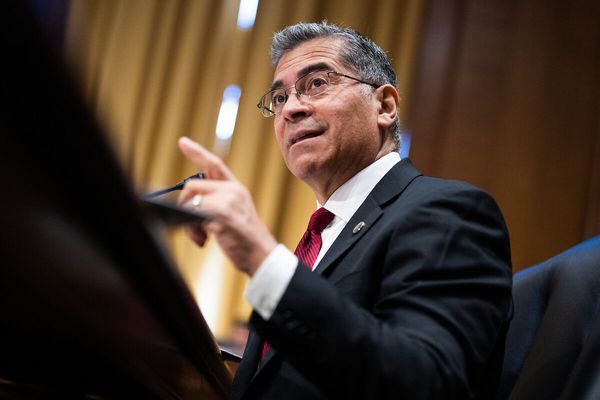Omicron has proven the most transmissible of any COVID-19 variant so far, straining hospital systems in every corner of the country. But it hasn’t changed the dynamics surrounding the politics of the pandemic in the states.
As the crisis grinds toward its third lethal year, states have shown little letup in their approaches to the emergency. The states that embraced restrictions to protect public health are poised to continue to do so in the coming year. Those intent on ensuring the pandemic does not impinge on what they regard as individual autonomy will continue to do so in 2022.
“We’re not really seeing states change course [in response to omicron] in terms of their policies and approaches in dealing with COVID overall,” said Jennifer Tolbert, director of state health reform at the Kaiser Family Foundation.
“For the most part, states that have imposed social distancing and have had masking and vaccine policies — or allowed local governments to institute them — are not changing those policies,” Tolbert said. “And states opposed to statewide masking and vaccine policies and social distancing continue to oppose them.”
Underlining that last point and expressing the sentiment of many of his fellow Republican governors, Georgia Gov. Brian Kemp told the Atlanta Journal-Constitution earlier this month that no matter what damage omicron inflicts, he has no intention of ordering lockdowns or mask or vaccine mandates.
“We’re not shutting down again. We’re going to weather through this,” he said. “This wave has been hard-hitting and fast, but hopefully it will be over very quickly.”
When it comes to COVID-19 and state policy, what’s past is likely to be prologue.
That divide is playing out even in how lawmakers conduct business. In West Virginia, for example, the Republican-controlled legislature is not requiring members to wear masks while in session despite the state’s record-breaking surge in COVID-19 cases. Meanwhile, the Vermont legislature voted to meet remotely at least for the first two weeks of the session.
Still, some less inflammatory subjects may bring bipartisanship. Those include addressing severe medical staffing shortages that have struck hospital systems during the delta and omicron surges and extending temporary measures that most states adopted early in the crisis to remove barriers to telehealth.
“As an unintended consequence, the pandemic caused us to try things that we may have been reluctant to try before,” said Andy Baker-White, senior director of state health policy for the Association of State and Territorial Health Officials. “And telehealth is one of those things. I remember speculating in spring of 2020, that these are things that aren’t going to go away.”
Legislators in Maryland, Virginia and other places also have filed measures to try to address shortcomings the pandemic revealed in long-term care facilities, which were devastated in the first months of the pandemic.
Some states also may try to make inroads on some of the systemic issues that pre-dated COVID-19 but have been amplified by the crisis, including deficiencies in mental health, substance use and youth suicide services. Some states also may aggressively attack the issue of health equity. The Association of State and Territorial Health Officials included boosting mental health and health equity among the top 10 public health state policies to watch in 2022, alongside protecting the authority of public health agencies, promoting vaccinations and bolstering the public health workforce.
State legislatures and governors also will be faced with decisions about how to spend more than $100 billion in additional federal COVID-19 aid yet to be distributed from the American Rescue Plan Act passed by Congress last year.
And states will address the pandemic through their 2022-23 budgets, a process that is only now beginning. Some governors have already announced initiatives, including California Democratic Gov. Gavin Newsom. Earlier this month he proposed $2.7 billion in state funding to increase testing capacity, accelerate vaccination and booster efforts, support front-line workers, strengthen the health care system and counter misinformation.
States of emergency
In the early days of the pandemic in 2020, all states declared a public health emergency, which gave governors and state public health authorities enhanced power to take measures to contain the coronavirus, such as ordering shutdowns, relaxing some licensing requirements for medical providers, and allowing health care facilities to open new units to accommodate more hospitalized patients.
Many states, including Alabama, Arkansas, Colorado, Florida, Maine and Massachusetts, allowed those emergency declarations to expire, particularly in the spring and summer of 2021 as more Americans received vaccinations.
In reaction to omicron, however, governors in some states, including Kansas, Louisiana, Maryland, New Jersey and New York, reimposed at least partial states of emergency. Kansas, which recently reinstated its state of emergency, allows some medical providers, such as licensed practical nurses, to perform certain patient care that normally must be supervised by a doctor. Today, about half the states are operating under states of emergency.
The emergency measures sparked a backlash in many places. Legislatures in a number of states took action last year to curtail state and local authority to impose COVID-19 related restrictions. Many Republican lawmakers are trying to continue that trend in 2022.
For example, lawmakers in Missouri and West Virginia have filed bills that would prevent school mask mandates. An Alabama measure would allow parents to opt out of a school masking requirement for their kids.
A federal judge earlier this month blocked parts of a new Tennessee law that prohibits schools from imposing a mask mandate. The decision came in response to a lawsuit by parents of children with disabilities. The state is seeking to overturn the judge’s order.
In Indiana, Iowa, Kentucky, Maine, Missouri and Pennsylvania, GOP legislators have filed bills that would restrict vaccine mandates. Some would prevent all government vaccine mandates. Some are specific to schools. Others would prohibit businesses from imposing a vaccine requirement on employees.
In Louisiana, Republican lawmakers want to prevent Democratic Gov. John Bel Edwards from joining California and Washington, D.C., in adding COVID-19 to the list of vaccines required for school.
Tolbert, of Kaiser, said she expects more Democratic-leaning states also eventually will move to make COVID-19 shots mandatory in schools, but likely not before the U.S. Food and Drug Administration gives full, rather than emergency, authorization for the vaccines for children.
In Missouri, a Republican representative filed a bill that would prevent health insurers from refusing to cover a resident or charge a higher premium for not being vaccinated. It also would prohibit insurers from providing incentives to doctors for achieving higher rates of COVID-19 immunizations.
Conversely, a bill from an Illinois Democrat would make unvaccinated patients pay out-of-pocket if hospitalized because of COVID-19. In New Hampshire, Democrats filed a bill that would require health insurers to provide financial incentives to patients getting vaccinated. A Virginia bill would authorize employer health plans to reward or penalize patients based on their COVID-19 vaccination status.
Bills filed in Florida, Missouri and New York would ensure that loved ones could visit family members with COVID-19 who are hospitalized or in long-term care facilities.
Addressing provider shortages
But lawmakers on both sides of the partisan divide could find agreement in some areas related to COVID-19, particularly on addressing shortages in medical providers.
Indiana, Mississippi, New Hampshire, New Jersey and other states are considering bills that would relax licensing rules to allow out-of-state practitioners to work in their states or provide temporary licenses to retirees or recent graduates during the COVID-19 or other public health emergencies.
Measures in Vermont and Washington would allow optometrists to provide vaccinations in a public health emergency. A bill in Indiana would grant the same authority to pharmacist technicians. A Delaware bill would speed up the training of nursing assistants.
Another broad area of agreement might be increasing access to telehealth, which proved popular among both doctors and patients. Such measures might include continuing reimbursement for telehealth services for a broader set of medical services than was possible before the pandemic.
Perhaps more than any legislation on the table, a Mississippi bill vividly captures the weight of the pandemic, which already has claimed an unfathomable number of lives: The measure would allow the state’s health department to store bodies when local morgues are overwhelmed.
———







